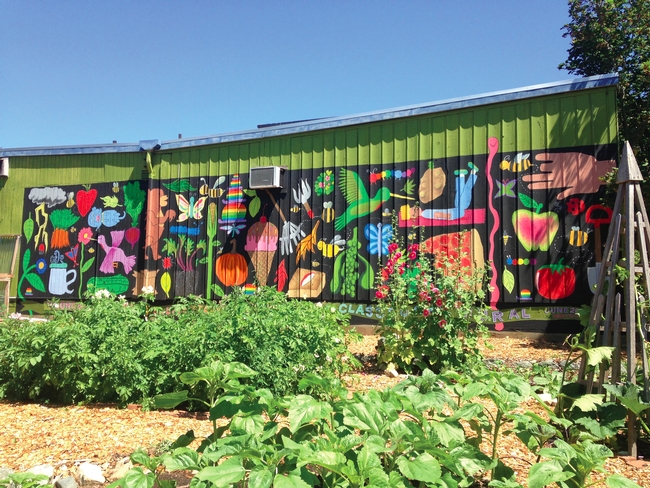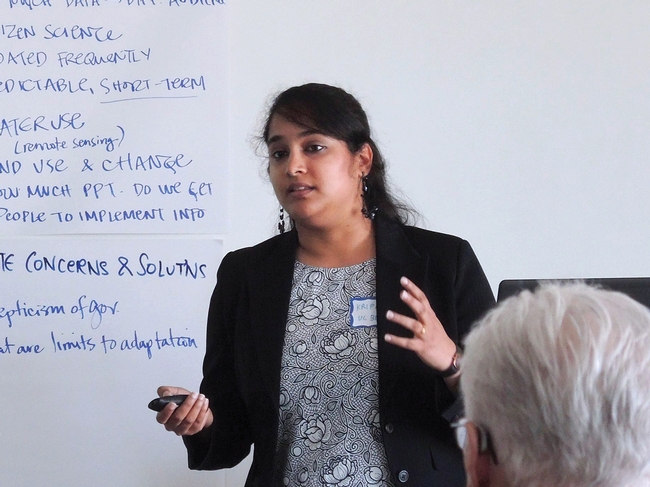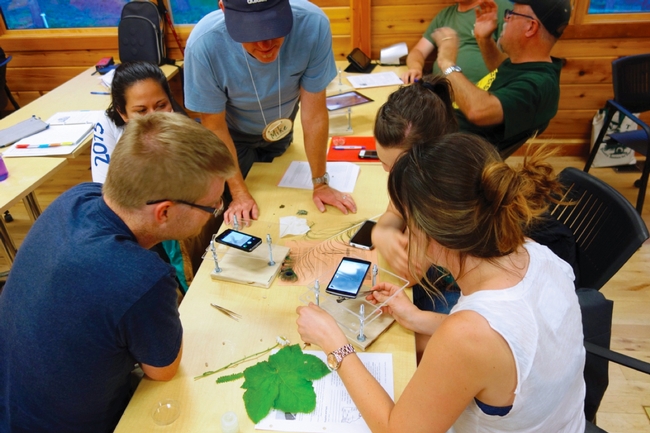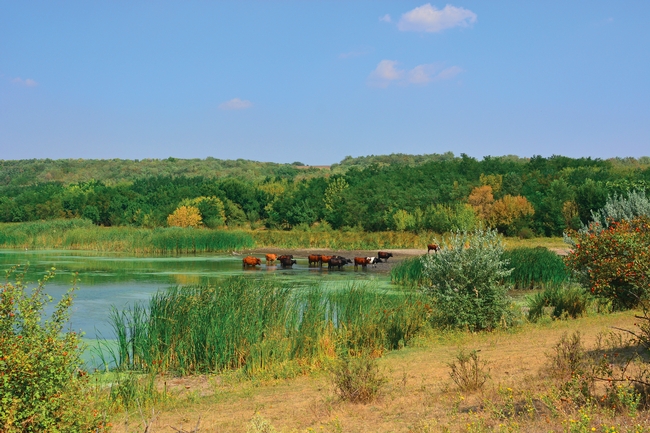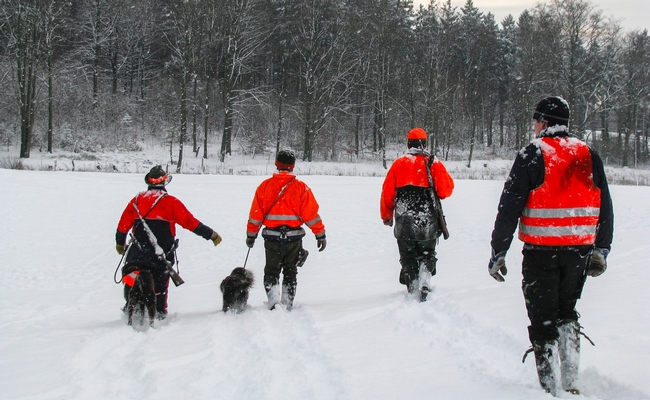Posts Tagged: School garden
Graduate Students in Extension study key California concerns
In 2013, a group of graduate students in the Department of Environmental Science, Policy, and Management (ESPM) at the University of California, Berkeley sought out faculty support and successfully collaborated with UC Agriculture and Natural Resources (UC ANR) to launch the Program for Graduate Students in Extension (GSE). Participants receive up to a year of funding to conduct applied research and outreach to California communities, coordinate workshops and training events, and co-author materials with ANR academics. Over the course of the three-year pilot program, 14 students from across the College of Natural Resources at UC Berkeley have participated.
“There's really no program quite like this, where students can gain hands-on, graduate-level training in extension and outreach,” says ESPM professor John Battles, who chaired the program's steering committee. He adds, “We're grateful to all the UC ANR advisors and specialists who have offered invaluable mentorship to student fellows.”
Sustainable Food Systems and Climate Education
Alana Siegner (Energy and Resources Group, 2016–17 fellow) believes that to ensure the environmental sustainability of agricultural landscapes and to improve health outcomes for young people, it's important that students understand the scientific and social causes and consequences of climate change as it plays out in the U.S. food system. During her fellowship, she adapted existing climate change curricula to fit within farm-to-school programs, integrating food- and farming-specific examples into general lessons on climate adaptation and mitigation. The lessons, designed for students in grades 8 through 10, are hands-on, interdisciplinary, and solutions oriented, unfolding in both the classroom and the school-garden environments. Siegner piloted the curricula and other professional development resources with teachers at schools in Oakland and in Washington State's San Juan Islands.
Climate-Resilient Agriculture
Despite several advances in modeling techniques, climate projections are not widely used in agricultural decision-making. Kripa Akila Jagannathan (ERG, 2015–16 fellow) wanted to bridge this gap between climate science and decision-making needs by improving the understanding of what farmers consider relevant climate information. She interviewed almond growers in California about how they'd previously used climate information, what climatic variables were most relevant to them, and the content and communication methods that could make information on future climate more usable. Jagannathan's interviews showed that almond growers have experienced changes in climate over the past few decades that have affected plant growth. She hopes that providing growers with appropriate information on past trends and future projections can help them to make decisions that are better adapted to future climate.
Forestry and Ecosystem Education
Stella Cousins (ESPM, 2014–15 fellow) collaborated with the Forestry Institute for Teachers, a free program that provides K–12 teachers in California with knowledge and tools for teaching their students about ecosystem science and forest resource management. In addition to presenting current research to participating educators, she shared do-it-yourself miniature microscopes that can help learners of all ages explore seeds, cells, fur, and other tiny wonders. Magnifying tree-core samples from the Sierra Nevada as an example, she demonstrated how a lesson in dendrochronology can facilitate classroom learning on the ways forests grow and are shaped by climate. Cousins says, “I hope that this project will support existing efforts to make sound and sustainable ecosystem-management choices, and also help foster lifelong curiosity in California's youth about the natural world.”
Conservation and Land Easements
Conservation easements are currently one of the primary channels for protecting private land. Since easements restrict development for both current and future owners, resale value is presumably diminished, and landowners are typically compensated with a one-time payment from a conservation group. Reid Johnsen (Agricultural and Resource Economics, 2016–17 fellow) wanted to explore the relationship between rancher identity, community, and potential preferences for alternative payment structures. He surveyed landowners in Marin and Sonoma counties to gauge their support for different options, including leases and annual payments for ecosystem services. He also constructed an economic model of stakeholder behavior to help assess which payment structure delivers the greatest combined welfare to landowners, conservation groups, and the public.
Hunting and Conservation
Luke Macaulay (ESPM, 2014–15 fellow) surveyed private landowners and land managers in California to determine how recreational hunting may influence decisions regarding land-use and conservation practices. He regularly spoke on his survey findings and ran a workshop in Montana to encourage cooperative conservation efforts between hunters and environmentalists. “The feedback from the advisors on my mentorship team was invaluable in improving the quality of my research,” he reflects. The experience also had an impact on his career: In 2016, Macaulay was hired by CNR as a Cooperative Extension specialist in rangeland planning and policy.
Growing more than veggies in California school gardens
Lately, I’ve seen the familiar signs of back-to-school. The school bus noisily pulls away from my neighbor’s house before the sun has fully risen. The neighborhood kids are inside a bit earlier in the evening (probably to finish that pesky homework), and I see throngs of students walk down the street with heavy backpacks slung low over their shoulders. But there are a few new signs in my neighborhood that school is back in session; kids with dirty jeans, mud stained at the knees from time spent in the school garden.
Interest in school gardens in California is high, and institutions are working to provide the resources to make school garden development a success. The UC Davis Children’s Garden Program, in collaboration with Life Lab Science Program and the Resource Conservation District of Greater San Diego County, has been working for over a decade to train those who wish to start school gardens that can provide positive experiences for students, but can also serve to enhance academics in the classroom. The workshops are intended to give communities the capacity to start their own school gardens while focusing on long term efforts to keep the gardens alive and thriving.
The Creating and Sustaining Your School Garden workshops teach the nuts and bolts of starting a garden, but also provide trainees with curriculum designed to bring many state-mandated education requirements into the garden. Beyond just a site for planting and harvest, the garden can be used, for example, as a space for young children to practice math skills like measuring, for middle school students to study civilizations of the world and for high school students to work on culinary arts, agricultural skills and entrepreneurship.
Between 2012 and 2014, the workshops aim to train approximately 700 school educators from throughout California. Additional “Train the Trainer” workshops seek to widen the circle further, providing mini-grants to organizations and schools interested in providing their own trainings on starting gardens.
Carol Hillhouse, director of the UC Davis Children’s Garden Program, housed at the Agricultural Sustainability Institute, has been creating and teaching garden-based learning since 1992.
“School gardens really should be regionally mentored,” says Hillhouse. “California is so geographically diverse. The way that we garden in the Central Valley is different from how we garden in the Imperial Valley or the Sierra foothills. So training new regional trainers has meant really effective mentors in different parts of the state. And our training materials provide a really simple way to get information out there that is easy for new trainers to use.”
Between 2007 and 2008, the workshops trained 180 trainers, who went on to train an additional 664 people in the practice of starting a school garden. The participants in those workshops represented nearly 300 schools, with a school population of 93,879. Participation in this year’s workshops is expected to yield similar results.
The sustained level of interest in these workshops and in school gardens in general over the years has been impressive.
”School gardens have held their own even in a very difficult economic climate and that says a lot and frankly has surprised me because I know how hard it is in schools these days," Hillhouse said. "The response now is as strong, if not stronger than it was when we first started these workshops in 2007. And at that point, through state legislation, schools were getting reasonable grants to develop their school gardens. There are not those same grants for these programs today, yet the interest is there.”
School budget cuts, threats to school programs and teacher salaries are a grim reality in California. But in the face of those challenges, school garden interest seems to grow. Still, gardens are not yet institutionalized within school budgets, and so their success depends on staff members, community and parent volunteers. Hillhouse advocates for gardens becoming more than expendable extras within schools.
“We still need additional research in this area but I know they can be very impactful. Over the long term they provide experiences for children that develop into a richly-scaffolded understanding of agriculture and food," she said.
“There’s a real power in gardening. Whenever you’re gardening, people want to see what’s happening and get their hands dirty. They get excited and want to start gardens in their own schools; this is a tangible way they can make their schools a better place. If we help hone that attitude from ‘we can put a garden here’ to ‘we can put a garden here, and it can help support our science curriculum, and it can help kids understand what to eat in the cafeteria, and it can even produce roses that we can put on the principals desk,’ then we have a viable program. Not just a garden, but a program that enriches a school in many ways”
Creating and Sustaining Your School Garden workshops along with workshops in other topics will be offered several more times around the state between now and June of 2014. Visit the UC Davis Children’s Garden Program website for information on dates and locations as they are scheduled and links to workshop registration.
Modern Education
Some of you may have heard what is going on at Nelda Mundy Elementary School in Green Valley. The Daily Republic newspaper ran a front page story on September 3rd about the successful garden being cultivated on the local elementary school campus. It is a progressive educational program that pairs classroom education with life lessons and hands on experiences. The garden is on the school campus and is tended to by student and adult volunteers. The school garden was very fortunate when the Green Valley Agricultural Conservancy provided $1000.00 to get the project off the ground. The garden was planted with tomatoes and other edibles and recently celebrated the first harvest. This is a learning opportunity for students to get first hand experiences with topics relating to gardening, farming, and plant biology. Unfortunately getting a public school garden started is something that cannot be successful without funding and volunteers, which makes it a difficult undertaking. At Nelda Mundy, the school administrators and parent volunteers are committed to the project. It is great to see a public school offering today's youth a well rounded education and going out of their way to do so.
link:www.dailyrepublic.com/media-post/nelda-mundy-elementary

nelda mundy in paper


